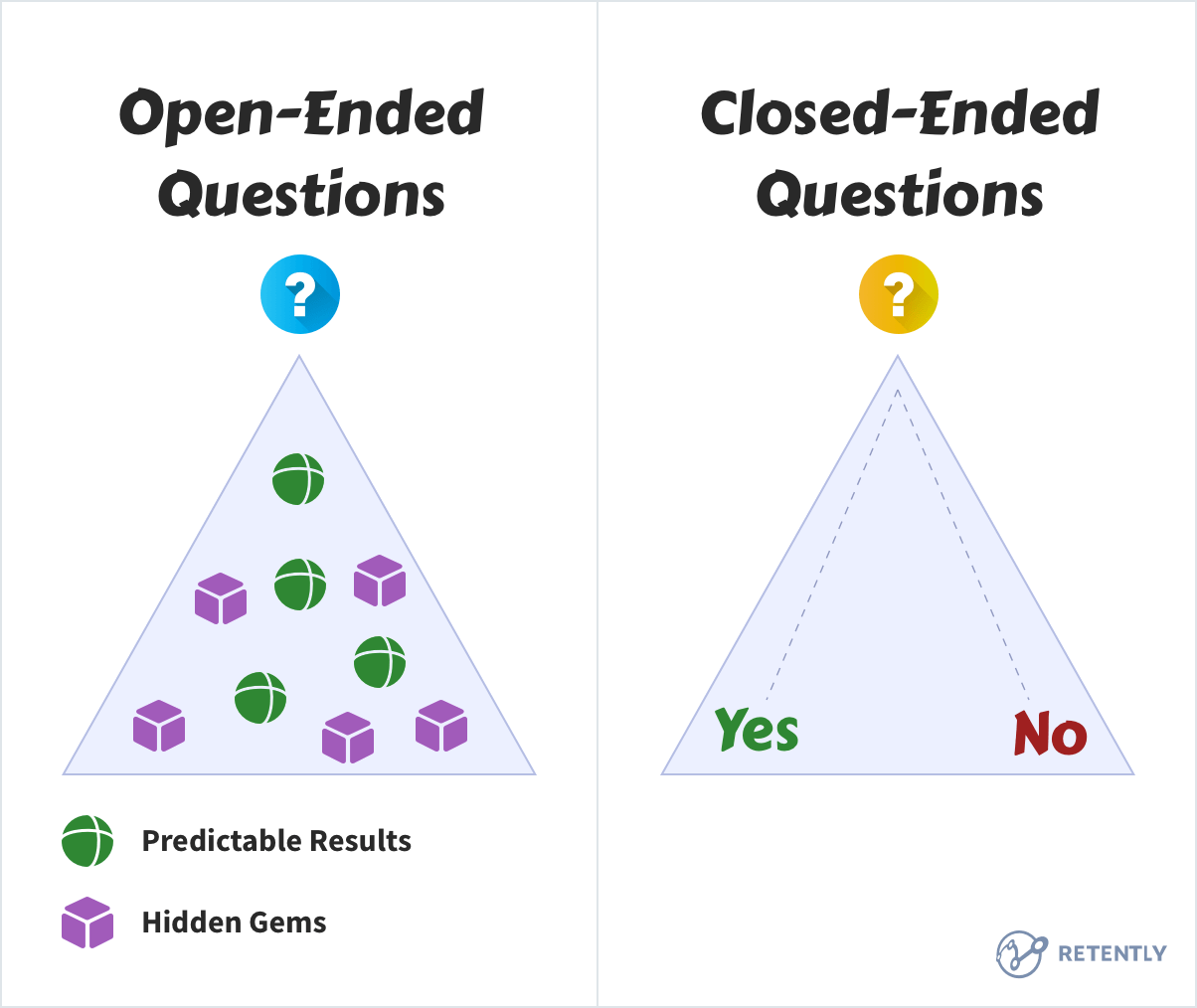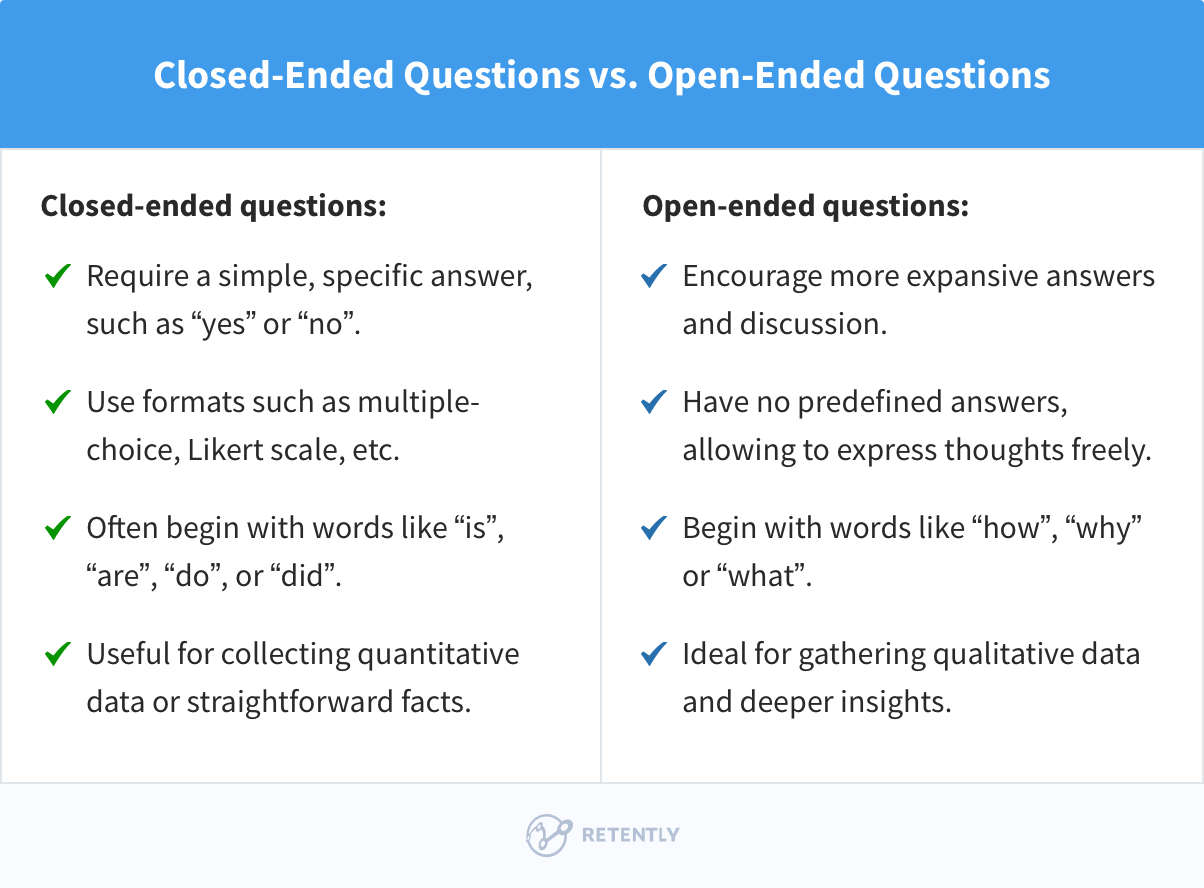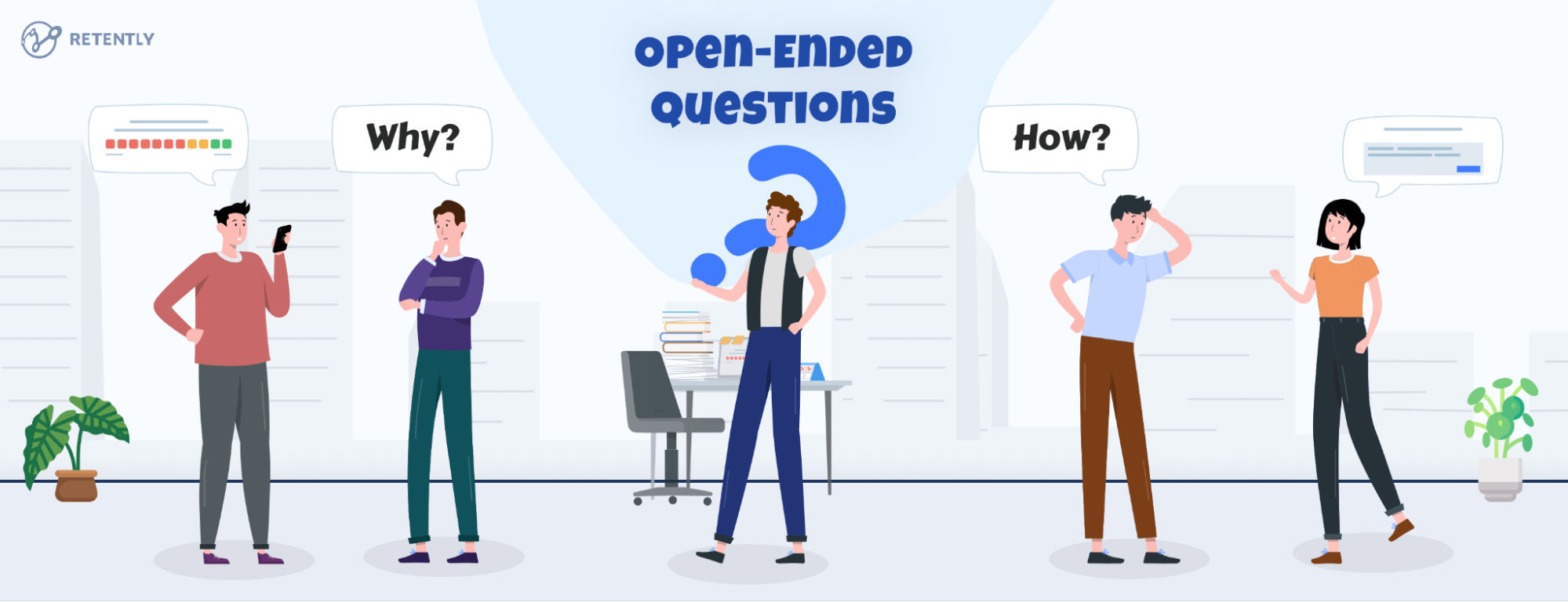Have you ever asked a question only to get a “yes” or “no” in response and wished you could uncover a little more? That’s where open-ended questions come into play, especially in the business world where every bit of feedback counts.
In this article, we’ll dive into some top open-ended question examples and explore why they’re so effective. Whether you’re looking to enhance your interviews, gather detailed survey responses, or improve customer feedback, you’ll find plenty of useful tips and insights. Let’s dive in!
Key Takeaways
- Open-ended questions bring out detailed and thoughtful responses, helping you understand things better and think more critically. They’re great for getting valuable insights across various contexts, such as customer feedback, team meetings or classroom discussions.
- Effective open-ended questions involve using specific starters like “How”, “Why” and “What”, avoiding leading questions and maintaining simplicity and clarity to ensure unbiased and meaningful responses.
- Analyzing responses to open-ended questions includes coding, identifying themes, and using data visualization techniques to uncover insights and guide informed decision-making.
What are Open-Ended Questions?
Open-ended questions are designed to encourage a full, meaningful answer using the respondent’s own knowledge, feelings, and thoughts. Instead of restricting responses to a single word or a choice among options, open-ended questions invite people to elaborate, explain, and engage more deeply.
Here are some of the characteristics of open-ended questions:
- they typically start with “how”, “why”, “what”, “describe”, or “tell me about”
- they allow for a wide range of responses
- they encourage detailed and thoughtful answers
- they are flexible and adaptable to any conversation
So, why are these types of questions so important, especially for businesses? It’s simple. Open-ended questions give your customers and employees the space to express themselves freely. This can lead to discoveries about what your business is doing well and what could be improved. Whether it’s through customer feedback surveys, product development meetings, or even routine employee check-ins, these questions can unveil the kind of detailed information that checkboxes and yes/no answers often miss.
Differences Between Open-Ended and Closed-Ended Questions
Understanding the difference between open-ended and closed-ended questions is key to using them effectively.
Closed-ended questions can be answered with a simple “yes” or “no”, or with a specific piece of information. They use formats such as multiple-choice or Likert scale survey questions. Closed-end questions are great when you need clear, concise data, but they don’t give much insight into someone’s thoughts or feelings.

For example, instead of asking “Did you like the new product?” (which is a closed-ended question), you might ask: “What did you think of the new product?”.
See the difference? Unlike closed-ended questions that box respondents into specific choices, open-ended queries encourage people to express their thoughts, feelings and reasons in their own words.
With these kinds of questions, you get to dive deeper into what really drives people’s opinions and behaviors. Closed-ended questions might only scratch the surface, but open-ended ones reveal the motivations and emotions behind those answers.
Here’s a more structured representation of the key differences:
Closed-ended questions:
- Require a simple, specific answer, such as “yes” or “no”
- Use formats such as multiple-choice or Likert scale.
- Often begin with words like “is”, “are”, “do”, or “did”.
- Are useful for gathering quantitative data or straightforward facts.
Open-ended questions:
- Encourage more expansive answers and discussion.
- Have no predefined answers, allowing to express thoughts freely.
- Begin with words like “how”, “why”, “what”, or are followed by “describe” or “ “tell me about”.
- Are ideal for gathering qualitative data and deeper insights.

When to Use Open-Ended Questions
Open-ended questions are ideal for a variety of use cases, such as:
- exploring new ideas
- creating surveys
- having meaningful conversations
- brainstorming sessions
Letting people share their thoughts freely through open-ended questions helps understand complex topics better. These questions can bring out different viewpoints, personal stories, and emotions that researchers might not expect, making them essential for exploring new ideas.
Surveys become much more valuable with open-ended questions. They let people give feedback in their own words, which improves the quality of the data. For example, Net Promoter Score (NPS) surveys ask open-ended questions to understand why customers gave a certain rating. This approach provides clear insights into customer opinions, helping businesses gather detailed information for strategic planning.
Open-ended questions are also relevant in interviews. They draw out detailed responses that show an interviewee’s skills and thought processes. For instance, asking, “What challenging project have you worked on, and how did you handle it?” allows the interviewee to highlight their problem-solving abilities.
During brainstorming sessions, open-ended questions encourage a wide range of ideas. They break free from limited answers, sparking creative thinking. For example, asking, “What unique strategies might we pursue to address this problem?” invites innovative ideas and boosts collaboration, leading to original and impactful solutions.
Benefits of Open-Ended Questions
One of the biggest and most obvious advantages of open-ended questions is that they encourage detailed responses and provides deeper insights. This is especially useful when you’re trying to understand someone’s experiences or opinions. For example, if you ask, “What did you enjoy most about our service?” you’re likely to get a much more informative answer than if you simply asked, “Did you like our service?”. This not only provides you with richer data but also helps you understand the nuances of their perspective. Detailed responses also make it easy to identify patterns and trends, leading to better decision-making.
But there is much more to it. Open-ended questions are powerful because they:
-
Promote Conversation and Engagement
Relationships in business aren’t too different from personal ones, they thrive on trust and communication. Open-ended questions are excellent tools for building that foundation, acting as conversation starters.
They show that you’re genuinely interested in what the other person has to say, which can make them feel more valued and willing to share. This is particularly important in customer service and feedback scenarios, where building a positive relationship with the customer can lead to greater loyalty and satisfaction. For instance, asking “How can we improve your experience?” opens up a dialogue that can lead to more engaged and satisfied customers.
It’s like saying, “Tell me more” and genuinely meaning it. The result? You don’t just talk at your customers, you talk with them. This deeper understanding that comes from free-flowing communication is invaluable – it helps businesses grasp not just what their customers want, but also how they think.
-
Reveal the Respondent’s True Feelings and Opinions
Sometimes, people need a bit of prompting to share their true feelings, thoughts, and opinions. Open-ended questions provide that nudge. They give respondents the freedom to express themselves fully and honestly. This can be invaluable in contexts like employee interviews, where understanding a candidate’s true motivations and feelings about a job can help you make better hiring decisions. For example, “What motivates you to do your best work?” can reveal much more about a candidate than a straightforward question about their skills.
Turning inwards, open-ended questions are just as powerful for your team. Internal surveys (like eNPS), with these questions can transform standard employee feedback into a goldmine of insights. Ask your team, “What changes would make you more satisfied with your workplace?” and watch the magic happen. Engaging your employees in this manner shows that you value their input and are committed to making real changes, fostering a more inclusive and dynamic workplace.
-
Enhance Critical Thinking and Reflection
By asking questions that require more than a simple answer, you encourage the respondent to think more deeply about the topic. This is particularly useful in educational settings, where teachers can use open-ended questions to encourage students to think critically about the material.
In business settings, open-ended questions are a bit like mental gymnastics. They push respondents to pause, ponder, and peel back the layers of their initial reactions. Asking, “How do you use our product in your daily life?” requires the respondent to reflect on their experiences, providing you with insights that are both broad and deeply personal.
Next, we’ll dive into some top examples of open-ended questions and discuss why they’re so effective in different contexts.
Examples of Open-Ended Questions in Business Surveys
Open-ended questions are priceless for gathering customer feedback. They let customers express their concerns and suggestions in their own words, giving you detailed insights that can help improve your products and services.
Let’s dive into some examples of how you can strategically use open-ended questions in various environments to see their impact and utility, starting with customer feedback questions:
1. Customer Satisfaction: Open-Ended Questions Examples
Gauging customer satisfaction is essential for any business looking to thrive. Open-ended questions can provide a deeper understanding of customer experiences and expectations. By asking these types of questions, you invite customers to share their thoughts and feelings freely, offering meaningful feedback that goes beyond simple ratings. Here are some examples:
- “What did you enjoy most about your experience with our product/service?”: This question helps you identify what aspects of your product or service are most appreciated by customers.
- “What could we do to improve your experience?” or “What can we improve on to make your experience better?”: This invites constructive feedback and suggestions for improvement, providing direct insights into areas needing attention.
- “What was your recent interaction with our customer service team like?”: This question encourages detailed feedback about customer service experiences, helping you to identify strengths and weaknesses in your customer support.
- “What suggestions do you have for our support team to serve you better?” or “How does our customer service compare to others you have experienced?”: Provides a reality check, offering insights into competitive standing and areas for improvement. By understanding what makes good customer service, businesses can address potential concerns and build trust.
- “What features or services would you like to see us offer in the future?”: Directs future product enhancements based on customer needs.
- “What was your overall experience with our product?”: Gathers comprehensive feedback and provides a broad view of customer satisfaction.
- “What specific instance comes to mind when you think of a time we exceeded your expectations?”: Offers powerful testimonials and success stories for marketing.
Here are some more examples:
- “Is there anything that disappointed you during your interaction with our company? Please elaborate.”
- “How likely are you to recommend our products/services to others, and why?”
- “What did you enjoy most about your experience with our product/service?”
- “What specific features do you find most valuable in our product/service?”
- “What was the biggest challenge you faced when using our product/service?”
- “How does our product/service compare to others you have used?”
- “What was your main reason for choosing our product/service?”
- “What are the most important benefits you get from using our product/service?”
- “If you could change one thing about our product/service, what would it be?”
- “What would make you more likely to recommend our product/service to others?”
These questions are designed to draw out specific likes and dislikes, allowing businesses to get a clear picture of what works and what might need adjustment.
2. Market Research: Open-Ended Questions Examples
For businesses looking to tap into new markets or assess existing ones, understanding consumer opinions and trends is key. Here are some examples of open-ended questions that can provide deep insights:
- “What factors influence your decision when choosing a product like ours?”: This question digs into the decision-making process, uncovering key influences and priorities for your target market.
- “How do you feel about the current offerings in our industry?”: This broad question invites respondents to share their views on market trends, potential gaps, and opportunities for innovation.
- “What features are most important to you in [a product or service], and why?”: This helps you understand customer needs and expectations, guiding product development and innovation strategies.
Let’s explore more ideas:
- What trends do you see becoming important in [industry/product category]?
- What would make this [product/service type] more appealing to you?”
- What unmet needs do you have that our product/service could address?”
- What do you think are the biggest trends in our industry right now?”
- How do you stay informed about new products/services in our industry?”
- What motivates you to try a new product/service in our industry?”
- What are the most important factors when you decide to switch from one product/service to another?”
- “What would your ideal product/service in our industry look like?”
- “What improvements or changes would make you more likely to purchase from us?”
- “What would your ideal shopping experience be like?”
These questions help uncover not just what consumers are thinking but also why they think that way, which is invaluable for strategic planning and product development.
3. Employee Engagement Surveys: Open-Ended Questions Examples
Engaging your employees and understanding their perspectives is essential for fostering a productive work environment. Open-ended questions can elicit honest and constructive feedback. Here are some effective examples to look into:
- “What do you enjoy most about working here?”: This question highlights positive aspects of the workplace, which can be leveraged to enhance overall job satisfaction.
- “What challenges do you face in your role? How can we help address them?”: This invites employees to share obstacles and suggests solutions, fostering a collaborative and supportive work environment.
- “What changes would you like to see in our company culture?”: This provides insights into employees’ perceptions of the company culture and suggestions for improvement, promoting a more inclusive and positive workplace.
For more open-ended question examples check the list below:
- “What changes would you suggest to improve our workplace environment?
- “What recent challenge did you face at work, and how did you handle it?”
- “What additional support or resources would help you perform your job better?”
- “How can we improve communication within the team/department/company?”
- “What recent achievement or success you’re proud of? Please describe.”
- “What skills or knowledge would you like to develop further?”
- “How can we improve the onboarding process for new employees?”
- “What do you think is the most important factor in creating a positive work environment?”
- “How can we better recognize and reward your contributions to the company?”
- “What changes would enhance your job satisfaction?”
- “What improvements would you suggest to our current workplace policies?”
- “How can we better support your professional growth?”
These questions encourage employees to share their true feelings and ideas, which can lead to meaningful changes and improvements in the workplace. They also signal to employees that their opinions are valued and considered in decision-making processes.
By integrating these examples of open-ended questions into your business surveys, you can enhance your understanding of customer satisfaction, market dynamics, and employee engagement, thereby enabling more informed and effective business decisions.
Additional Use Cases
But open-ended questions aren’t just great for surveys. They work wonders in team meetings and interviews, sparking deeper discussions and creative ideas. In classrooms, they help students express their thoughts and think critically. Let’s see how:
Team Meeting Questions
During team meetings, asking open-ended questions can really boost transparency and creativity. For instance, asking, “What aspects of our meetings do you find most effective or least effective, and why?” lets team members share crucial insights that can help improve how meetings are run. This type of question fosters an open dialogue, encouraging everyone to voice their opinions and suggestions.
Try asking, “If you were to lead a meeting next week, what would you do differently?” or “In your experience, how do our team’s discussions stack up against others within the company?”. These questions can draw out individual preferences and innovative ideas. The feedback you get from such questions is invaluable for making meaningful improvements.
Here are some more ideas:
- “What are some creative ways we can tackle our current project challenges?”
- “How do you think we can improve team communication?”
- “What recent successes can we learn from and replicate in future projects?”
Open-ended questions are key to identifying what makes a meeting productive and bring in a wide range of perspectives, enhancing team efficiency.
Classroom Discussion Questions
In classroom discussions, open-ended questions really get the creative juices flowing and help students understand things on a deeper level. For example, asking, “What would you do if you were a teacher for a day?” encourages students to explore different perspectives and share their unique ideas. These questions invite students to dig deeper into the topics and provide detailed responses, building a more engaging learning experience.
Some more relevant ideas for an open-ended question example could be:
- “How would you explain this concept to a friend?”: Helps students reinforce their understanding and improve communication skills.
- “What did you find most interesting about today’s lesson?”: Identifies engaging content and helps tailor future lessons.
- “What real-life example can you think of that relates to this topic?”: Connects theory to practice, enhancing understanding.
- “What questions do you still have about this topic?”: Promotes further inquiry and continuous learning.
Crafting Effective Open-Ended Questions and Common Pitfalls to Avoid
Creating open-ended questions that elicit meaningful and insightful responses can be a bit of an art. It’s all about framing your questions in a way that encourages detailed answers and honest feedback. Let’s dive into some tips to help you craft effective open-ended questions.
1. Use Specific Starters
When you use open-ended questions, you typically start with “How,” “Why,” or “What.” For example, asking “How” encourages people to explain processes or experiences, giving you lots of details about their perspectives or feelings. Similarly, starting with “What” prompts more in-depth descriptions, uncovering the deeper layers of their reasoning and emotions.
By asking “Why,” you get people to delve into their reasons or justifications, fostering deep reflection and revealing the motives behind their actions or beliefs.
Yet, be cautious with “Why” questions. While they naturally encourage detailed answers, they can sometimes make people defensive. It’s better to frame these questions in a way that invites thoughtful reflection. For example, instead of “Why didn’t you like our service?” you might ask, “What aspects of our service didn’t meet your expectations, and how can we improve them?”
Using these starters helps you create effective open-ended questions that lead to comprehensive and meaningful answers, far beyond simple yes or no replies.
2. Avoid Leading Questions
Avoiding leading questions is essential if you want to keep your feedback unbiased and authentic. Leading questions can push someone toward a specific answer, which can mess up the true feedback you’re looking for. For example, asking, “Don’t you think our product is great?” already suggests the answer you want, which might influence how people respond.
To avoid this pitfall, make sure your questions are neutral. This way, people feel comfortable sharing their genuine thoughts and opinions, leading to more meaningful and reliable insights.
3. Keep It Simple and Clear
Open-ended questions, in particular, need to be clear so that people can grasp what you’re asking and give meaningful answers.
Avoid being too vague. Asking something like, “What is your opinion on our company?” can be too broad and hard to interpret. Instead, try to narrow down your focus. For example, “In what ways do you think our company could enhance its services, and why?”. This directs respondents to give you specific, clear insights.
Don’t use complicated language or jargon. This helps prevent confusion and makes it easier for respondents to share their opinions and experiences.
By simplifying your question wording and structure, you allow people to focus on giving thoughtful, detailed responses instead of getting tripped up by confusing phrasing. This straightforward approach leads to better feedback quality and more insightful information, whether you’re looking for detailed answers or just a few words.
4. Be Specific, Yet Open
Watch out for questions that seem open-ended but actually limit responses. Ensure your questions genuinely allow for detailed answers. Also, consider making the response fields optional and keep the number of open-ended questions low to maintain high completion rates while still gathering quality data.
For a balanced survey, mix multiple-choice options with both closed-ended and open-ended questions. This way, you can get a variety of data without overwhelming your respondents.
5. Mind the Context
Make sure your questions are relevant to the situation. For example, if you’re conducting a survey about a new product, your questions should focus on aspects related to that product. “What features do you find most useful in our new app?” is specific and contextually appropriate.
For more ideas, make sure to check our guide on bad survey questions.
Analyzing Responses to Open-Ended Questions
Analyzing responses to open-ended questions can be a bit like piecing together a puzzle. Here’s how you can do it:
- Categorize the Data: Start by sorting the feedback into different categories. This helps you see what types of responses you’re getting.
- Spot Recurring Themes: Look for common themes or patterns in the answers. Are multiple customers mentioning the same issue or praising the same feature? These recurring themes are your key insights.
- Use Data Visualization: Transform this qualitative feedback into visual stories. Charts, word clouds, and graphs can make the data easier to understand and more engaging to share.
These findings are key for making informed decisions and creating effective strategies. It’s like turning a bunch of thoughts into a clear action plan.
Let’s look into some techniques that are worth considering:
-
Coding
When you get a bunch of detailed survey responses, making sense of all that information might seem overwhelming. That’s where coding comes in. Coding is like putting labels on each response to highlight the main idea or topic. This helps you summarize the survey results more efficiently.
This can be done manually or with software. For example, responses like “quick delivery” and “fast shipping” can be coded under “delivery speed”.
There are two main ways to code data: deductive and inductive.
- Deductive Coding: This method uses pre-existing codes based on established theories or assumptions. You apply these codes to the new data. The downside? It can lead to biased interpretations since you’re starting with certain expectations about what the responses should reveal.
- Inductive Coding: This approach lets the data speak for itself. You create codes directly from the responses without any preconceived categories. This way, themes and patterns naturally emerge from the data, giving you a more unbiased view.
Once you have your codes, you organize them into a “coding frame”. This can be either flat or hierarchical, depending on your needs. The coding frame helps structure the themes you’ve identified, ensuring your findings are relevant across different scenarios.
-
Thematic Analysis
This involves identifying patterns or themes within the responses. Start by reading through all the responses and noting recurring ideas. These themes can help you understand common concerns, preferences, or suggestions. For instance, if multiple customers mention “speed of service” as a concern, it becomes a significant theme to address. Thematic analysis helps you see the bigger picture and understand the main issues or positives highlighted by respondents.
-
Sentiment Analysis
This method assesses the emotional tone of responses. Are customers generally positive, negative, or neutral about your product or service? Sentiment analysis tools or specialized survey software can automate this process, highlighting the overall mood of your feedback. For example, if a significant number of responses are positive but mention specific areas for improvement, you know what to keep and what to work on.
-
Content Analysis
This is a more structured approach, where you categorize responses based on predefined criteria. It helps quantify qualitative data. For instance, if you’re analyzing feedback on a new product, you might categorize responses into “design”, “functionality”, “price” and “customer service”.
Unlike thematic analysis, which is more interpretative, content analysis is more structured and quantitative, allowing you to count the frequency of themes or words. This can be useful for identifying how often certain issues are mentioned, giving you a sense of their importance to your respondents.
By employing these techniques, you can transform raw data into actionable insights that reveal deeper meanings and trends.
Case Studies: Examples of Successful Implementation
Let’s explore some examples of how organizations have successfully implemented insights gained from open-ended questions:
- Starbucks: Starbucks frequently uses customer feedback to improve its offerings. By analyzing responses to open-ended questions, they have introduced new flavors, improved store layouts, and enhanced customer service training programs. This customer-centric approach has helped Starbucks maintain high levels of customer satisfaction and loyalty.
- Airbnb: Airbnb uses open-ended questions in their host and guest feedback surveys to gather detailed insights. This feedback has led to the development of new features like Instant Booking and improved search filters. By listening to their community, Airbnb continuously enhances the user experience for both hosts and guests.
- Zappos: Zappos, known for its exceptional customer service, uses open-ended questions to understand customer needs deeply. Insights from these responses have led to various customer-friendly policies, such as free shipping and easy returns, which have significantly boosted customer satisfaction and loyalty.
By analyzing and using the responses to open-ended questions, you can make informed decisions that enhance customer satisfaction, drive innovation, and align strategies with customer needs. This helps in improving products and services and fosters a deeper connection with customers, leading to long-term success.
Conclusion
Open-ended questions are efficient tools that go beyond simple yes-or-no answers to uncover deeper insights, foster engagement and reveal true feelings and thoughts. They are indispensable in various contexts – whether you’re interviewing a candidate, conducting a survey, gathering customer feedback, teaching, or coaching.
Incorporating open-ended questions into your interactions can significantly improve the quality of information you gather and the relationships you build. By asking the right questions, you can capture valuable insights that drive better decisions and stronger connections with others.
You’ll be amazed at how much more you can learn and understand by simply asking questions that invite detailed responses. Better communication and deeper understanding are just a few questions away. Embrace the benefits of open-ended questions with Retently in a free trial and start making your interactions richer and more insightful. Make sure to check out this survey builder for instant question ideas.
We’d love to hear from you! What are some of your favorite open-ended questions? Share them with us and let’s put together the best questions that have helped you gain valuable insights and foster meaningful interactions.


































 Christina Sol
Christina Sol 


 Greg Raileanu
Greg Raileanu 

